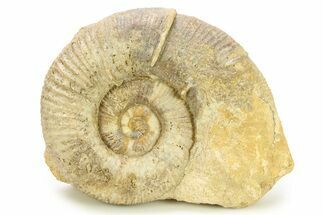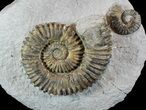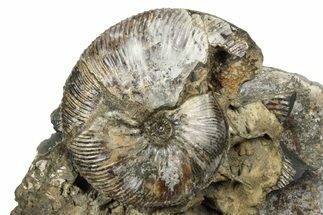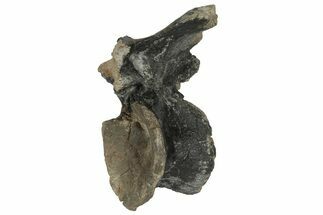This Specimen has been sold.
4.2" Fossil Ammonites (Aegocrioceras) on Rock - Germany
This is a pair of unusual Aegocrioceras ammonites collected near Groß Resse, Germany. There are a few crack repairs and some minor gap fill restoration on the specimen. The center ammonite on what could be considered the front of the rock is 4.2" wide, with a 1.4" wide ammonite sitting adjacent to the center ammonite. The back side of the rock also features an ammonite that measures 3.7" wide.
The rock that these ammonites are on is 7" x 6.3".
The rock that these ammonites are on is 7" x 6.3".
About Ammonites
Ammonites were ancient marine cephalopods, similar to today's squids and octopuses, but with a defining feature: their distinctive, tightly coiled spiral shells. These shells, resembling those of modern nautiluses, served as both a protective home and a buoyancy aid, allowing ammonites to navigate the prehistoric seas with ease. First emerging around 240 million years ago in the Triassic Period, ammonites thrived for over 175 million years, adapting through numerous forms and sizes. As predatory creatures, they likely fed on smaller marine organisms, using their tentacles to capture prey. However, their long reign came to an end 65 million years ago at the close of the Cretaceous, coinciding with the mass extinction event that also eliminated the dinosaurs.
Ammonites were ancient marine cephalopods, similar to today's squids and octopuses, but with a defining feature: their distinctive, tightly coiled spiral shells. These shells, resembling those of modern nautiluses, served as both a protective home and a buoyancy aid, allowing ammonites to navigate the prehistoric seas with ease. First emerging around 240 million years ago in the Triassic Period, ammonites thrived for over 175 million years, adapting through numerous forms and sizes. As predatory creatures, they likely fed on smaller marine organisms, using their tentacles to capture prey. However, their long reign came to an end 65 million years ago at the close of the Cretaceous, coinciding with the mass extinction event that also eliminated the dinosaurs.
SPECIES
Aegocrioceras sp.
LOCATION
Groß Resse, Germany
SIZE
4.2" & 1.4" wide (front) and 3.7" wide (back). 7 x 6.3" rock
CATEGORY
SUB CATEGORY
ITEM
#77950
We guarantee the authenticity of all of our specimens.
 Reviews
Reviews















